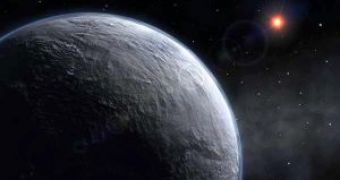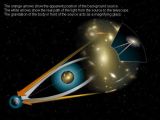Detecting Earth-like planets orbiting distant stars is quite a difficult task. The large distances make it impossible to see the light reflected by the planets as it is engulfed by the light of the star itself. Thus, astronomers detect the planets by detecting what gravitational impact they have.
Astronomers use an effect predicted by Einstein in a 1936 paper called "Lens-like Action of a Star by the Deviation of Light in the Gravitational Field". According to the general theory of relativity the gravitational force is not really a force, it is simply an expression of the fact that masses cause deformations of the space-time. In a certain metaphorical sense you can imagine how an object placed on a soft surface, e.g. on a couch, leaves a dent on the surface. If a small ball moves on the surface and approaches the dent its trajectory will change because of the dent - it is as if the other object attracts it with a force. This is just a metaphorical view because gravitation actually leaves a dent in space-time, and not just in space - in fact its main influence is on time, rather than on space.
The importance of this view is that it predicts that not only massive bodies are influenced by gravitation (as Newton thought), it says that everything, even particles such as photons, which have no mass, is influenced by gravitation. The gravitational lensing effect (described in the image below) appears when a certain massive body is in front of some light source. The massive body is bending the trajectory of light in a similar way to how a magnifying glass is bending light. Thus, astronomers can use this effect in order to see enlarged pictures of various portions of the sky.
The microlensing technique, now used to detect small planets, and which in principle could detect planets even ten times smaller than Earth, is based on the following fact: if the light source being monitored has a planet around it (or more planets), when there's an alignment Earth - large body providing the gravitational lens - planet - star, the planet produces an additional gravitational effect (the microlensing effect) that can be detected. An animation of how one can detect a planet with this method can be found here (credit: Trent Schindler, National Science Foundation).
Basically, what happens it that as the foreground object passes before the star, the star temporarily (for about a month) looks brighter. The orbiting planet makes the star look even brighter, but only for several hours or days.
Insofar, this technique has discovered only few, very large, planets. The point is that astronomers cannot produce the lensing effects; they simply have to wait for such alignments to happen. However, more stars they're monitoring, more likely it is they find such events.
The international collaboration called OGLE (Optical Gravitational Lensing Experiment) monitors 170 million stars in the Milky Way's central "bulge". There is yet another consortium called PLANET (Probing Lensing Anomalies NETwork) in Australia that also monitors such events.
OGLE identifies annually around 1000 such microlensing events, and now, for the first time, a relatively small planet was discovered, 22 000 light years from the Sun. The planet could be as small as 2.8 Earth masses, or as large as 11.0. This uncertainty is caused by the fact that astronomers need to know the mass of the star around which the planet is orbiting. This newly discovered planet orbits a red dwarf - which in a small star (they are usually from 10% to 50% of the Sun's mass), the most common type of star (about 85% of all the stars in the galaxy are red dwarfs).
This discovery is important for two reasons. Firstly, it allows researchers to test theories of planet formation around red dwarfs. And secondly, it allows them to see how many Jupiter-sized planets (hundreds of times larger than Earth) are there in comparison with the number of smaller planets. Other techniques have revealed that Jupiter-sized planets are rather rare - only a few red dwarfs have been found to harbor them - but those techniques are simply not sensitive enough to detect smaller bodies.
"The new discovery provides a strong hint that low-mass planets may be much more common than Jupiters," said co-author and PLANET researcher David Bennett of the University of Notre Dame. "Microlensing should have discovered dozens of Jupiters by now if they were as common as these five-Earth-mass planets. This illustrates the primary strength of the gravitational microlensing method: its ability to find planets of low-mass."
Scott Gaudi of the Harvard-Smithsonian Center for Astrophysics in Cambridge speculates about the reasons why Jupiter planets are rare: "Everything happens much slower around red dwarfs," he told New Scientist Magazine. "Planets simply do not have the opportunity to grow as large as Jupiter because the star's radiation blows away their dusty, gassy building materials before they can grow. You end up with small, puny things and not a lot of giant things."
This new planet, with the revelatory name of OGLE-2005-BLG-390Lb, appears to orbit its star at a distance about 2.6 times greater than that between the Sun and the Earth. However, the red dwarf shines so weakly compared to the Sun that the planet's surface is probably as frigid as Neptune or Pluto's (about -220?C).
Astronomers say the find is an important milestone for microlensing. Two other planets had been found with the technique since 2004, but each was several times the mass of Jupiter. "They've proven they can detect these low-mass things," says Sara Seager of the Carnegie Institution of Washington in Washington DC, US. "It's just a matter of time before they get more." "There are really no other methods at present that can detect planets of this mass and at this separation," agrees Andrew Gould of Ohio State University in Columbus, US. He argues that microlensing searches should be intensified by upgrading cameras to cover a wider view of the sky and dedicating more time and telescopes to monitor the galactic bulge. "For a long time, we've worked on detecting planets with whatever was at hand, making use of existing small telescopes or even amateur telescopes. It's time to move on to the next stage."
Image Credits: ESO; NASA

 14 DAY TRIAL //
14 DAY TRIAL // 
